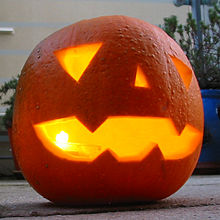A modern jack-o'-lantern is a carved
pumpkin, although originally large turnips were carved. It is associated
chiefly with the holiday of Samhain and Halloween and was named after the
phenomenon of strange light flickering over peat bogs, called ignis fatuus
or jack-o'-lantern. In a jack-o'-lantern, the top is cut off, and the
inside flesh then scooped out; an image, usually a monstrous face, is
carved out, and the lid replaced. It is typically seen during Halloween.
Pumpkin carving is thought to come from
Ireland, where turnips, mangelwurzel or beets were used. Turnip lanterns, sometimes
with faces carved into them, were made on the Gaelic festival of Samhain
(31 October–1November) in Ireland and the Scottish
Highlands. Samhain was a time when fairies and spirits were said to be active. The purpose of these lanterns may have been threefold. They may have been used to light one's way while
outside on Samhain night; to represent the spirits and otherworldly
beings; and/or to protect oneself and one's home from them. Bettina Arnold
writes that they were sometimes set on windowsills to keep them out of
one's home. However, others suggest that they originated with All Saints'
Day (1November) /All Souls' Day (2 November) and that they represented Christian souls in purgatory.
Related Posts

No comments:
Post a Comment